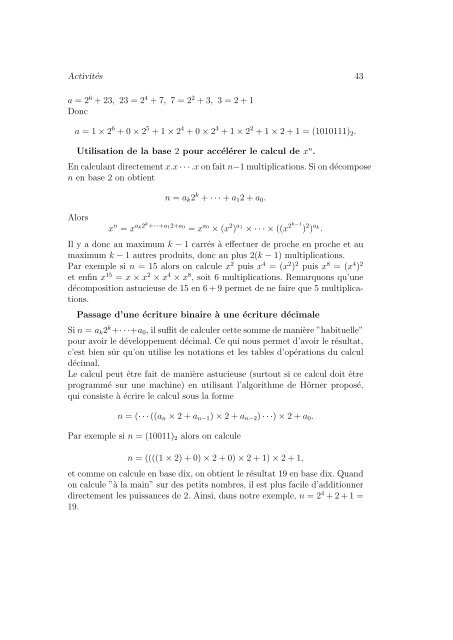Cours et activités en arithmétique pour les classes ... - Robert Rolland
Cours et activités en arithmétique pour les classes ... - Robert Rolland
Cours et activités en arithmétique pour les classes ... - Robert Rolland
You also want an ePaper? Increase the reach of your titles
YUMPU automatically turns print PDFs into web optimized ePapers that Google loves.
Activités 43<br />
a = 2 6 + 23, 23 = 2 4 + 7, 7 = 2 2 + 3, 3 = 2 + 1<br />
Donc<br />
a = 1 × 2 6 + 0 × 2 5 + 1 × 2 4 + 0 × 2 3 + 1 × 2 2 + 1 × 2 + 1 = (1010111)2.<br />
Utilisation de la base 2 <strong>pour</strong> accélérer le calcul de x n .<br />
En calculant directem<strong>en</strong>t x.x · · · .x on fait n−1 multiplications. Si on décompose<br />
n <strong>en</strong> base 2 on obti<strong>en</strong>t<br />
Alors<br />
n = ak2 k + · · · + a12 + a0.<br />
x n = x ak2 k +···+a12+a0 = x a0 × (x 2 ) a1 × · · · × ((x 2 k−1<br />
) 2 ) ak .<br />
Il y a donc au maximum k − 1 carrés à effectuer de proche <strong>en</strong> proche <strong>et</strong> au<br />
maximum k − 1 autres produits, donc au plus 2(k − 1) multiplications.<br />
Par exemple si n = 15 alors on calcule x 2 puis x 4 = (x 2 ) 2 puis x 8 = (x 4 ) 2<br />
<strong>et</strong> <strong>en</strong>fin x 15 = x × x 2 × x 4 × x 8 , soit 6 multiplications. Remarquons qu’une<br />
décomposition astucieuse de 15 <strong>en</strong> 6 + 9 perm<strong>et</strong> de ne faire que 5 multiplications.<br />
Passage d’une écriture binaire à une écriture décimale<br />
Si n = ak2 k +· · ·+a0, il suffit de calculer c<strong>et</strong>te somme de manière ”habituelle”<br />
<strong>pour</strong> avoir le développem<strong>en</strong>t décimal. Ce qui nous perm<strong>et</strong> d’avoir le résultat,<br />
c’est bi<strong>en</strong> sûr qu’on utilise <strong>les</strong> notations <strong>et</strong> <strong>les</strong> tab<strong>les</strong> d’opérations du calcul<br />
décimal.<br />
Le calcul peut être fait de manière astucieuse (surtout si ce calcul doit être<br />
programmé sur une machine) <strong>en</strong> utilisant l’algorithme de Hörner proposé,<br />
qui consiste à écrire le calcul sous la forme<br />
n = (· · · ((an × 2 + an−1) × 2 + an−2) · · ·) × 2 + a0.<br />
Par exemple si n = (10011)2 alors on calcule<br />
n = ((((1 × 2) + 0) × 2 + 0) × 2 + 1) × 2 + 1,<br />
<strong>et</strong> comme on calcule <strong>en</strong> base dix, on obti<strong>en</strong>t le résultat 19 <strong>en</strong> base dix. Quand<br />
on calcule ”à la main” sur des p<strong>et</strong>its nombres, il est plus facile d’additionner<br />
directem<strong>en</strong>t <strong>les</strong> puissances de 2. Ainsi, dans notre exemple, n = 2 4 + 2 + 1 =<br />
19.


